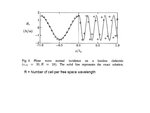ghasem_008
Full Member level 4
hi.
I have one problem with dielectric interface in 1D fdtd by YEE method.
I have a plane wave that normally incident to an air-dielectric interface.
dielectric is lossless with permitivity of 20.
source is sinusoidal that excite domain from left side:
Ey(1) = source;
the problem is one dimensional.
in the following figure:
"YEE solution" suffered from a complete phase reversal with respect to the "exact solution" after propagating only "one free space wavelength" inside the dense dielectric.
how???
in this example:
number of cell per wavelength is = 20
dielectric permitivity = 20
is there anyone who can give me a code that simulate this figure in one dimensional FDTD?

I have one problem with dielectric interface in 1D fdtd by YEE method.
I have a plane wave that normally incident to an air-dielectric interface.
dielectric is lossless with permitivity of 20.
source is sinusoidal that excite domain from left side:
Ey(1) = source;
the problem is one dimensional.
in the following figure:
"YEE solution" suffered from a complete phase reversal with respect to the "exact solution" after propagating only "one free space wavelength" inside the dense dielectric.
how???
in this example:
number of cell per wavelength is = 20
dielectric permitivity = 20
is there anyone who can give me a code that simulate this figure in one dimensional FDTD?
